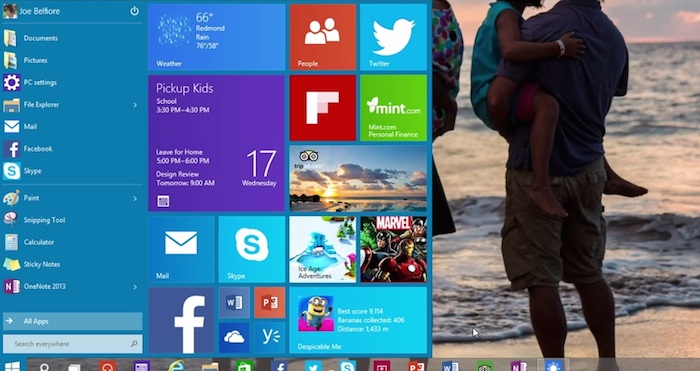Start menu, Window applications, Continuum.
Windows 10 is not only an operating system, but an ecosystem potentially compatible with all types of devices on the market. It can be installed both on embedded systems, on tiny objects without display, until you get to the Smart TV or even to Surface Hub, computers with huge display that Microsoft wants to place in the meeting rooms of large companies.
Many of the innovations designed for the new operating system are designed precisely in order to make the user interface accessible on systems very different from each other, and in this category include, for example: the new Start Menu, applications executable in modern window and, specifically, how Continuum.
Personal opinion : Windows 8 is a great operating system with a poor user interface. The problem is that, as the name implies, it just serves to interface with your computer, and if the first approach is negative is unfortunately likely that the comments that follow will be negative. Microsoft has tried to patch up the mistakes made with Windows 8, releasing a 8.1 slightly more rated for use with mouse and keyboard, still the most widely used on desktops, notebooks and 2-in-1.
But it was not enough. Because strategically the company released the news most awaited only with Windows 10, almost forcing you to step – mischievously offered for free – the latest version of the operating system to use them.

The most expected is of course the dear old traditional Start Menu, which is not only a return to the roots – as recently said Nadella – but an interface designed by Microsoft to make a frame to the Store, which the company plans to do the bulk of the turnover in the Windows environment. The Start Menu of Windows 10 on the structure of the old menu of Windows XP, Vista and Seven, but adds obvious connotation’s graphics in the style Modern launched 8.
It is divided mainly into two columns: on the left, we will find shortcuts (customizable) to Explore resources, Control Panel, Documents and applications used or the latest installed; the right column the tile customizable by the user.
The Start menu is still available even though the same size – not too popular on the desktop – Windows 8, that is, the full screen. All thanks to Continuum, proprietary technology from Microsoft that allows you to adapt the interface of the device according to the typology.
This is a feature that becomes more interesting with the hybrid devices – or 2-in-1, if you prefer – you can easily switch between modes automatically based on the input devices connected. For example: if you unplug the keyboard to the tablet form, Windows 10 will notify us of the event asking us if we want to enter the Tablet Mode.
We can choose to do it or continue to use the operating system in the traditional mode, and of course we can ” to remember ” the choice so that each time will link or unlink the device. Windows 10 will perform the same operation. Tablet Mode lets you use the device with an interface very similar to that of Windows 8, with applications to be launched in full screen and with a management of the multi-window very similar. Likewise also the Start Menu, as we wrote above, it will be proposed to the full screen. The option can be changed of course also in a second time, at the discretion of the user.
In the traditional mode applications will be performed either in a window or full screen, and this is perhaps the most interesting feature of Windows 10 in terms of the graphical interface. Both executable’s traditional software in a ” Modern ” are now handled as if they were common windows.
This is a new very pleasant, especially for desktop and notebook users, who can now use apps from the Store a clearly more effective with mouse and keyboard. Native applications are developed for Windows 10 and then vertically, as we have become accustomed to decades of computer history: scrolling Contents are from above to below, and vice versa, as is typical in other platforms.
Windows 8 Microsoft pointed out a strange scroll horizontally, which fortunately seems to have been supplanted entirely on the new release. It is clear that, if you want to bet on the Store must make sure that the contents of the same are usable by the greatest possible number of users, and with Windows 8 this – unfortunately – did not happen.


